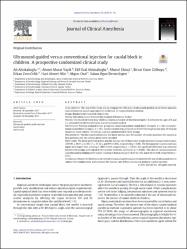| dc.contributor.author | Ahıskalıoğlu, Ali | |
| dc.contributor.author | Yayık, Ahmet Murat | |
| dc.contributor.author | Oral Ahıskalıoğlu, Elif | |
| dc.contributor.author | Ekinci, Mürsel | |
| dc.contributor.author | Gölboyu, Birzat Emre | |
| dc.contributor.author | Çelik, Erkan Cem | |
| dc.contributor.author | Alıcı, Hacı Ahmet | |
| dc.contributor.author | Oral, Akgün | |
| dc.contributor.author | Demirdöğen, Şaban Oǧuz | |
| dc.date.accessioned | 10.07.201910:49:13 | |
| dc.date.accessioned | 2019-07-10T19:57:40Z | |
| dc.date.available | 10.07.201910:49:13 | |
| dc.date.available | 2019-07-10T19:57:40Z | |
| dc.date.issued | 2018 | en_US |
| dc.identifier.citation | Ahıskalıoğlu, A., Yayık, A. M., Oral Ahıskalıoğlu, E., Ekinci, M., Gölboyu, B. E., Çelik, E. C. ... Demirdöğen, Ş. O. (2018). Ultrasound-guided versus conventional injection for caudal block in children: A prospective randomized clinical study. Journal of Clinical Anesthesia, 44, 91-96. https://dx.doi.org/10.1016/j.jclinane.2017.11.011 | en_US |
| dc.identifier.issn | 0952-8180 | |
| dc.identifier.issn | 1873-4529 | |
| dc.identifier.uri | https://dx.doi.org/10.1016/j.jclinane.2017.11.011 | |
| dc.identifier.uri | https://hdl.handle.net/20.500.12511/3025 | |
| dc.description | WOS: 000423137700039 | en_US |
| dc.description | PubMed ID: 29161549 | en_US |
| dc.description.abstract | Study objective: The aim of this study was to compare the efficacies of ultrasound guided sacral hiatus injection and conventional sacral canal injection performed for caudal block in children. Design: Randomized controlled clinical trial. Setting: Operating rooms of university hospital of Erzurum, Turkey. Patients: One hundred-thirty four children, American Society of Anesthesiologists I-II, between the ages of 5 and 12, scheduled for elective phimosis and circumcision surgery. Interventions: Patients assigned to two groups for ultrasound guided caudal block (Group U, n = 68) or conventional caudal block (Group C, n = 66). Caudal solution was prepared as 0.125% levobupivacaine plus 10 mcg/kg morphine (total volume: 0.5 ml/kg), and was administered to both groups. Measurements: The block performing time, the block success rate, the number of needle puncture, the success at first puncture and the complications were recorded. Main results: The block performing time and the success rate of block were similar between Group U and Group C (109.96 +/- 49.73 s vs 103.17 +/- 45.12 s, and 97% vs 93%, respectively p > 0.05). The first puncture success rate was higher in Group U than in Group C (80% vs 63%, respectively p = 0.026). No significant difference was observed between the groups with regard to the number of needle punctures (p = 0.060). The rates of vascular puncture and subcutaneus bulging were higher in Group C than in Group U (8/66 vs 1/68, and 8/66 vs 0/68, respectively p < 0.05). Conclusions: Despite the limitations in central neuroaxial anesthesia we recommend the use of ultrasound since it reduces the complications and increases the success rate of first puncture in pediatric caudal injection. | en_US |
| dc.language.iso | eng | en_US |
| dc.publisher | Elsevier Science Inc | en_US |
| dc.rights | info:eu-repo/semantics/embargoedAccess | en_US |
| dc.subject | Ultrasound Guided Caudal Injection | en_US |
| dc.subject | Sacral Hiatus | en_US |
| dc.subject | Sacral Canal | en_US |
| dc.subject | Pediatrics | en_US |
| dc.subject | Analgesia | en_US |
| dc.subject | Caudal Block | en_US |
| dc.title | Ultrasound-guided versus conventional injection for caudal block in children: A prospective randomized clinical study | en_US |
| dc.type | article | en_US |
| dc.relation.ispartof | Journal of Clinical Anesthesia | en_US |
| dc.department | İstanbul Medipol Üniversitesi, Tıp Fakültesi, Cerrahi Tıp Bilimleri Bölümü, Anesteziyoloji ve Reanimasyon Ana Bilim Dalı | en_US |
| dc.authorid | 0000-0002-5580-5960 | en_US |
| dc.identifier.volume | 44 | en_US |
| dc.identifier.startpage | 91 | en_US |
| dc.identifier.endpage | 96 | en_US |
| dc.relation.publicationcategory | Makale - Uluslararası Hakemli Dergi - Kurum Öğretim Elemanı | en_US |
| dc.identifier.doi | 10.1016/j.jclinane.2017.11.011 | en_US |
| dc.identifier.wosquality | Q1 | en_US |
| dc.identifier.scopusquality | Q2 | en_US |


















